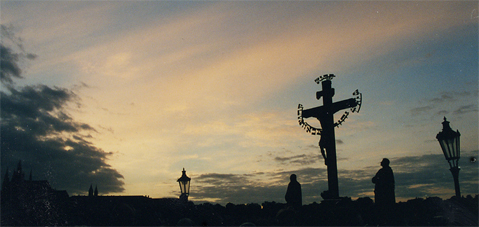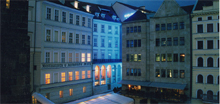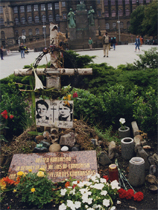Prague and the Czech Republic
Refined and bewitching Prague saw Russia’s invasion
as only one in a series of occupations in their long struggle for independence
and nationhood. If you talk to a Czech today and refer to their country
as lying in “Eastern Europe” they sometimes politely, but sometimes gruffly correct
you. “Central Europe” they suggest. What’s in a name? Even though these
Central European nations have been influenced by such ideas as the Renaissance
and the Reformation they are now trying to catch up to their western nations.
They do not want to be confused with their Russian neighbors, who have that most awkward
Eastern inclination towards despositism. “We want NATO. We want the EU.
We are the West.” All of these hopes and aspirations are suggested
with their insistence of “Central Europe.” These people know that the
20th century’s Cold War was one of the conflicts of east and west.
Russians might look European but Mother Russia’s heart was molded in the
great wastelands of Central Asia.
 Charles Bridge must be one of the most enchanting bridges in Europe.
The stone bridge has imposing but beautifully crafted statues of saints and
heroes on of both sides of the narrow lane. King Charles supposedly built
the bridge to remind the people of Prague of man’s smallness and of god’s greatness.
Halfway down the bridge is the obligatory statue of Jesus. However this
crucifix is different from any other. Centuries before the Holocaust
a Jew had been found guilty of blasphemy and his punishment was to surround
the crucifix with the words proclaiming Jesus’ greatness in Hebrew letters
of gold. Both the good and bad ideas of Europe reached
Prague.
Charles Bridge must be one of the most enchanting bridges in Europe.
The stone bridge has imposing but beautifully crafted statues of saints and
heroes on of both sides of the narrow lane. King Charles supposedly built
the bridge to remind the people of Prague of man’s smallness and of god’s greatness.
Halfway down the bridge is the obligatory statue of Jesus. However this
crucifix is different from any other. Centuries before the Holocaust
a Jew had been found guilty of blasphemy and his punishment was to surround
the crucifix with the words proclaiming Jesus’ greatness in Hebrew letters
of gold. Both the good and bad ideas of Europe reached
Prague.

At the end of the Charles Bridge is “Central Europe’s Largest Disco - ”
at least that’s what the massive neon sign advertises.

While Eastern despots understand revolutions of soldiers and would be dictators,
they have a harder time with revolutionaries who use weapons of the mind.
When the city went to far during Khrushchev’s “de-Stalinfication” in the Prague
Spring of 1968 a student named Jan Palach poured gasoline and set himself
on fire to protest the soviet occupation of his country. The
Czechs blooming revolution against their Eastern oppressors died with him.
 On one side of the Town Square is a early 15th century Gothic astronomical
clock. Every hour on the hour skeletons ring bells, apostles
appear, and a cock crows. For 50 years this landmark could entertain
only Eastern Europeans. Now that the wall has fallen and the West has
discovered Prague again the city is invaded by tourists. The clock
does it dance for huge
On one side of the Town Square is a early 15th century Gothic astronomical
clock. Every hour on the hour skeletons ring bells, apostles
appear, and a cock crows. For 50 years this landmark could entertain
only Eastern Europeans. Now that the wall has fallen and the West has
discovered Prague again the city is invaded by tourists. The clock
does it dance for huge
 crowds every hour.
crowds every hour.
 The statue of religious reformer Jan Hus, which dominates the center of Prague’s
old town square, reminds the visitor how the ideas of Europe had filtered
into Prague. Like Western Europe, a thinker, not a despot dominates
the town’s old square.
The statue of religious reformer Jan Hus, which dominates the center of Prague’s
old town square, reminds the visitor how the ideas of Europe had filtered
into Prague. Like Western Europe, a thinker, not a despot dominates
the town’s old square.
Back To Home
Page
About Me: I am a History teacher who wants to transform my hobby of
Travel Photography into paying for my summer vacations. If you would
like to use any of my images in your magazine or web site please contact
me at kevinrpatterson@hotmail.com.
I also have many more images not found in this site from Mexico, Peru, Bolivia,
Jordan, Syria, Hungary, Spain, Turkey, Czech Republic, Bosnia, and Romania.
 Charles Bridge must be one of the most enchanting bridges in Europe.
The stone bridge has imposing but beautifully crafted statues of saints and
heroes on of both sides of the narrow lane. King Charles supposedly built
the bridge to remind the people of Prague of man’s smallness and of god’s greatness.
Halfway down the bridge is the obligatory statue of Jesus. However this
crucifix is different from any other. Centuries before the Holocaust
a Jew had been found guilty of blasphemy and his punishment was to surround
the crucifix with the words proclaiming Jesus’ greatness in Hebrew letters
of gold. Both the good and bad ideas of Europe reached
Prague.
Charles Bridge must be one of the most enchanting bridges in Europe.
The stone bridge has imposing but beautifully crafted statues of saints and
heroes on of both sides of the narrow lane. King Charles supposedly built
the bridge to remind the people of Prague of man’s smallness and of god’s greatness.
Halfway down the bridge is the obligatory statue of Jesus. However this
crucifix is different from any other. Centuries before the Holocaust
a Jew had been found guilty of blasphemy and his punishment was to surround
the crucifix with the words proclaiming Jesus’ greatness in Hebrew letters
of gold. Both the good and bad ideas of Europe reached
Prague.

 On one side of the Town Square is a early 15th century Gothic astronomical
clock. Every hour on the hour skeletons ring bells, apostles
appear, and a cock crows. For 50 years this landmark could entertain
only Eastern Europeans. Now that the wall has fallen and the West has
discovered Prague again the city is invaded by tourists. The clock
does it dance for huge
On one side of the Town Square is a early 15th century Gothic astronomical
clock. Every hour on the hour skeletons ring bells, apostles
appear, and a cock crows. For 50 years this landmark could entertain
only Eastern Europeans. Now that the wall has fallen and the West has
discovered Prague again the city is invaded by tourists. The clock
does it dance for huge
 crowds every hour.
crowds every hour. The statue of religious reformer Jan Hus, which dominates the center of Prague’s
old town square, reminds the visitor how the ideas of Europe had filtered
into Prague. Like Western Europe, a thinker, not a despot dominates
the town’s old square.
The statue of religious reformer Jan Hus, which dominates the center of Prague’s
old town square, reminds the visitor how the ideas of Europe had filtered
into Prague. Like Western Europe, a thinker, not a despot dominates
the town’s old square.